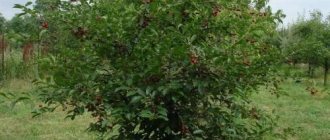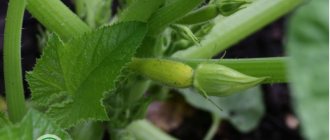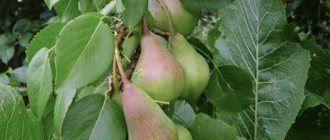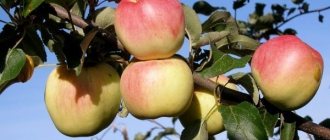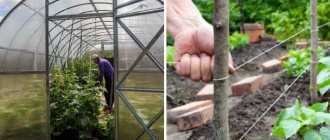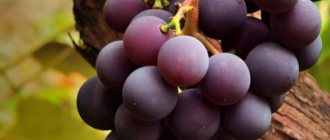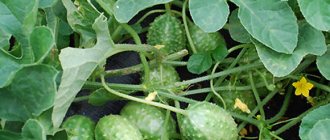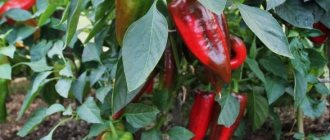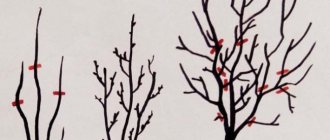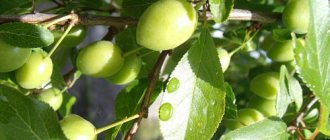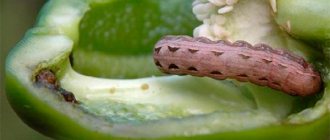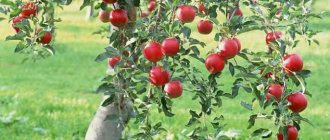Apricot variety for Siberia
Apricot varieties for Siberia:
- One of the best varieties for growing in Siberia is the Sayan hybrid. The tree is short, growing no more than 3 m in height. The flowering period begins in May. Up to 15 kg of fruits are collected from one mature tree. The weight of the berry is 20 g.
- Mountain Abakan is a low-growing variety, reaching a height of about 3 m. The main advantage of the variety is frost resistance. The berries weigh from 20 to 35 g. The skin is orange in color with a slight red blush.
- Another universal apricot variety for growing in Siberia is Northern Lights. A self-sterile hybrid; pollinating plants are planted nearby to pollinate the inflorescences. The tree is compact and low. Fruits weighing 20-35 g. Up to 20 kg of crop is harvested from an adult plant.
- East Siberian is an early variety, flowering begins in the first half of May. Apricots ripen in the second ten days of July. Productivity from 10 to 15 kg.
There are not many varieties of apricots for growing in the Siberian regions. Due to climatic conditions, growing an apricot tree is quite problematic.
The best varieties for the Urals
When cultivating apricot in the Urals, one should take into account the requirements of the southern culture: resistance to freezing of crown branches at temperatures of -37...40 °C and below, resistance to prolonged Ural thaws, and recurrent freezing. It is also important to take into account the resistance to early spring desiccation of shoots, the resistance of generative buds and bark to warming under conditions of low snow cover.
Chelyabinsk early
Universal purpose, early ripening, partially self-fertile. Seedling of Manchurian apricot, allocated to the elite in 1986, authors Mullayanov L.K., Putyatin V.I. Pankratova A.E.
The tree is medium-sized, the crown is open, medium density, medium leafy. The leaf is rounded-pointed, green, and quite large. The fruits are 16-22 g, yellow, with small dots of anthocyanin tan. The pulp is light orange, moderately dense, of good taste. Frost resistance of wood and buds is good, as is winter hardiness in general, drought resistance is moderate. The yield is average, the taste rating is 4.2.
Kichiginsky
Medium-late, self-sterile (pollinators Piquant, Chelyabinsk Early), universal purpose, highly winter-hardy. Obtained at the Chelyabinsk Institute of Horticulture and Vegetable Growing in the late 90s by crossing Manchurian and Siberian apricots. Authors Mullayanov L.K., Pankratova A.E.
Tree of medium height, fast growing type. The fruits are not large, 12-15 g, yellow, round, with delicate yellow pulp, easily separated seeds, sweet and sour, good transportability. Taste rating 4.5.
Spicy
Universal purpose, mid-late, partially self-fertile (pollinators Chelyabinsk Early, Kichiginsky). It is a seedling of the Manchurian apricot, authors Authors Mullayanov L.K., Pankratova A.E., Zamyatina I.G., Putyatin V.I. Included in the State Register in 1999.
The crown of a medium-sized tree is quite spreading, with medium foliage. The leaf is dark green, dense, rounded. The fruits are round, yellow, with dark red dots of outer color, weighing up to 16 g, yellow aromatic pulp, juicy and very tasty, freely detachable stone. Taste rating 3.9.
Snezhinsky
Medium early, partially self-fertile, high winter hardiness, universal purpose.
It is a seedling of the Piquant apricot, obtained on the basis of YuUNIISK in 2000. Authors F. M. Gasimov, Mullayanov K. K. The height of a medium-spreading tree is 3 m, the crown diameter is up to 4.7 m. The leaves are distinguished by an intense green color, rounded, large. The weight of the rounded fruit is 17-22 g, the color of the thin, slightly detachable skin is yellow, with a small number of subcutaneous reddish dots. The pulp is moderately dense, juicy, sweet. Transportability is moderate, tasting score 4.9 points.
Uralets
Medium early, universal, with low self-fertility. Obtained on the basis of YUNIISK by the method of free pollination of several cultural forms, incl. apricot Kichiginsky. Authorship belongs to Gasimov F.M., Mullayanov K.K. At State variety testing since 2006
The tree is medium-sized, of moderate foliage, with a spreading, not dense crown, reddish fruit shoots, and numerous protruding lentils. The leaf is intense green, oval-round, large. The fruits are round, yellow in color, densely covered with small anthocyanin dots. The pulp has a delicate consistency, sweet, light orange, and good taste. Frost resistance, winter hardiness, and drought resistance are quite high. Tasting score 4.7.
As for the timing of fruiting for apricots in the Urals and Siberia, there is practically no exact data due to the different soil and climatic conditions of the region. A variable climate and a change in varietal characteristics when grown by seed propagation or with certain grafting methods also play a role. Beginning gardeners will find it useful to have a summary table of the approximate maturation times of the crop.
| Groups of varieties | Approximate ripening dates |
| Early | July 5-15 |
| Medium ripening | July 15-25 |
| Late | July 25 – early August |
And in conclusion, it is worth noting that apricot is a culture of care. Let them call the plant southern - the inexhaustible enthusiasm of breeders has expanded its distribution area from the Baltic to Western Siberia, and thanks to the rare diligence and perseverance of gardeners, the southern fruit delights us in northern gardens.
Choosing a landing site
In Siberia, finding a place to plant apricots is more difficult than in the south due to the climate. It is recommended to plant apricot trees in partial shade, in areas sheltered from cold winds. It is undesirable to plant trees in the sun because in the spring the buds will begin to swell early, and they will die when spring frosts return.
It is not advisable to plant seedlings in lowlands where water accumulates. Plants are undemanding to soil composition and can grow on any type of soil.
Plants prefer to grow on loose, fertile soils. If the soil is infertile, then more fertilizer should be added to it before planting the seedling.
Medium ripening apricots
Apricot "Polesie Yeti".
Also in our country, fruits of medium ripeness are very popular. These include
Polessky is a man of great fruits; Monastery; Crimean murders; Red neck and others.
Polessky is a large fruit. Previously it was Kitaevsky. Medium-sized trees have a thick crown. It must be diluted regularly. Polessky is characterized by large fruits weighing 55 grams. They have a round oval shape. From mid-summer the variety begins to develop in full force.
Interesting fact: according to the latest data, there are about 44 varieties of apricot in our country. And there are even black apricots!
Second red cheek. In the case of apricots, the fruits are of medium size and weigh about 35 grams. The spouting egg-shaped fruit has a bright orange color and a pleasant taste. The plant is undemanding and tolerates winter well. The trees are of medium height and have a large, thick crown.
Three Crimean murders. Apricot Crimean Amor is especially popular among gardeners because of its large fruits, the weight of which reaches 90 grams. They taste good and taste good. The fruits are round in shape and have thin skin and can be stored for a long time. They are often used for processing.
Apricot Monastery
Fourth monastery. Fruit trees are quite large and have an extensive crown. The average weight of the fruit is 40 g. In some cases they weigh up to 50 grams. They ripen at the end of summer. The fruit content is highly dependent on the temperature regime in the region. So when the summer is hot, the fruits ripen a little earlier. Trees resist frost well in order to survive the winter well. The fruits are used both raw and as preservatives. They make delicious jams and compotes.
Important: The wood is not frost-resistant enough and needs special growing conditions.
Five. Petropavlovsky. Apricot Petropavlovsky belongs to a large fruit variety. In this case, the weight of the fruit can reach 100 g. The plant is not afraid of diseases and tolerates somewhat harsh weather conditions. The fruits ripen in mid-summer. They are used in the production of jams, compotes and preserves. They can also be used raw.
Landing technology
Planting apricots in Siberia is not much different from planting seedlings in other regions. Apricots are heat-loving plants that rarely survive frosty winters. Therefore, whether the tree will freeze in winter or not depends on the correct technique for planting seedlings.
See also
Description of the best varieties of columnar apricot Prince Mart, Zvezdny, planting and care rulesRead
Planting apricots in Siberia:
- Dig a hole at least 50 cm deep, the width of the hole should also be at least 50 cm and no more than 80 cm.
- The pit is filled with manure, superphosphate, and potassium sulfate in a ratio of 10 l x 500 g x 500 g.
- Mix fertilizers with soil.
- Seedlings should be planted a few weeks after fertilizing so that the soil is saturated with useful substances.
- After 2-3 weeks the seedling is planted.
- The tree is placed in a hole, the roots are straightened and soil is added.
- The root collar is left on the surface 5 cm from the soil.
- Compact the soil around the trunk and water generously with warm water.
In Siberia, it is recommended to plant apricot seedlings in the spring with the onset of warm weather, when the threat of night frosts has passed. A stake is placed next to the young seedling and the trunk is tied to it. If the hole is in a lowland, then you need to make good drainage so that the water does not stagnate and the soil is not waterlogged.
The benefits and harms of Siberian apricot fruits
Apricot in the Urals (planting and care)
Seeds, leaves, bark and ripe fruits are saturated with poisonous toxins that pose a threat to human life only in large quantities. Small doses of these substances act exactly the opposite: like medicine. Apricot kernels contain the substance amygdalin, which is used in asthma medications, is used as an antiseptic, and even treats coughs.
Thanks to this substance, the seeds are used to improve digestion and stimulate respiratory processes. In addition, Siberian apricot seeds are used to produce high-quality almond oil and almond water. In folk medicine, the seeds are used to treat nervous disorders and skin diseases. Siberian folk healers note the positive use of tinctures of shrub leaves containing hydrocyanic acid as a means of destroying cancer cells.
Siberian apricot fruits
Tree care
When growing apricots in the southern regions, they do not spend much time on care. But if you plant plants in Siberia, you will have to take a lot of care for the tree. Since northern latitudes are not suitable for cultivating the plant, you will always have to be on guard so that the tree does not die.
Watering and fertilizing
The frequency of watering apricots depends on a number of factors, which include:
- Age of the tree.
- Growing season.
- Climatic conditions.
- Soil structure.
Young trees need watering more than older ones. The first watering is carried out in April, when the shoots bloom. Apricots are watered a second time when the inflorescences bloom and at the end of this period. The third time - a few weeks before the fruits begin to ripen. And the last watering is carried out in October. Before watering, loosen the soil and remove all weeds.
Another important aspect in caring for apricot trees is the application of mineral and organic fertilizers. Apricots are fed in spring, summer and autumn.
In spring, the plant is fed with nitrogen-containing fertilizers, which promote growth. Such fertilizers are applied to the soil next to the trunk. The first time nitrogen is fed during flowering and the second time after flowering. In the last fertilizing, organic matter is also added along with nitrogen. In summer, preference is given to foliar feeding. In summer, plants also require nitrogen. The leaves are sprayed with nitrogen-containing fertilizers.
With the onset of July, fertilizing should be comprehensive. And in August, preference should be given to organic matter.
In the fall, fertilizing is aimed at preparing for winter. In the autumn, mineral fertilizers are applied. In order for the apricot to survive the harsh winter, phosphorus, potassium and calcium are added to the soil in smaller quantities. To saturate the soil with potassium and phosphorus, the soil around the trunk is covered with wood ash. To saturate the soil with calcium, chalk or special complex fertilizers are used. It is not recommended to apply nitrogen-containing fertilizers, as they promote growth activation.
See also
Description of the hybrid with the taste of plum and apricot sharafugi, characteristics and featuresRead
Apricot - planting and care in the middle zone, in the Urals, in Siberia in spring, autumn, video
A biological feature of apricot is a short period of winter dormancy. As long as the temperatures remain consistently low, the tree tolerates the cold without problems, however, starting from the second half of winter, the plant is sensitive to weather changes: as soon as the frost gives way to a thaw, the apricot comes to life.
It is at this moment that the tree becomes defenseless against a sharp cold snap - the awakened buds can be damaged by even minor frosts. From this point of view, the consistently cold climate of the Far East and Eastern Siberia may be more favorable for apricots than the changeable weather of the Moscow region and the southern regions of Siberia.
In Western Siberia, the fruit tree is faced with another problem - the bark getting warm. This is due to the fact that in the region, heavy snowfalls are sometimes accompanied by high air temperatures, as a result of which the roots of the tree are in soft (not frozen) soil, but cannot breathe due to the dense snowdrift on the surface. Such an imbalance leads to disruption of the wood structure, as a result of which the apricot dies.
Important! In regions located north of Voronezh, the death of apricots after winter is overwhelmingly explained by the warming of the bark.
Knowing these features of the species, experienced gardeners use some tricks to avoid problems with the tree.
- The best rootstock for apricots grown in regions with snowy and unstable winters are plum, cherry plum or damson. These trees are not afraid of stagnation of water in the root collar, however, the height of the trunk before grafting must be at least 60–80 cm; in addition, when choosing the shape of the rootstock, it is important to take into account its compatibility with a particular variety.
- It is better to plant a seedling not on a flat surface, but on a slope. If the terrain does not imply hilliness, the slope must be artificially organized by building a hill on the site with a diameter of about 2 m and a height of at least 0.5 m. At the top of this hill, a hole is dug and a tree is planted in it. In order for the “hill” to keep its shape, it is better to sow it abundantly with lawn grass that has a dense but shallow root system.
- When planting apricots, the root collar should not be allowed to deepen.
- There should be no sides to retain water along the edges of the tree trunk circle.
- The standard pre-winter watering in the south for apricots grown in cold regions is not carried out.
Until recently, growing the exotic southern apricot in Siberia seemed like a fantastic event. However, breeders and gardeners in the Siberian region are breeding this fruit crop and harvesting a bountiful harvest of delicious apricot fruits. Siberian apricots are not much different in taste from their southern “brothers”: they are basically the same juicy and sweet.
In Siberia, it is not the ordinary apricot that grows, but its hybrids, obtained by crossing the usual apricot crop with a local Siberian variety growing in the taiga. From its wild “progenitor”, the hybrid variety inherited remarkable winter hardiness, allowing it to withstand severe Siberian frosts and difficult climatic conditions.
Successful cultivation of apricots in Siberia depends on the selection of a suitable variety that meets the increased requirements of winter hardiness, disease resistance and fertility. Local breeders managed to develop many new varietal species with the required criteria:
- Sayan. Winter-hardy, disease-resistant variety, with juicy yellow fruits reaching a weight of 30 grams. The sweet pulp of ripe fruits is orange in color, has a delicate structure and a pleasant sourness. From one mature tree you can harvest up to 45 kg of delicious apricots. The height of the tree reaches 3 meters. A wide crown of medium density with ovoid leaves and a toothed edge.
- Superior. This variety is a real leader among winter-hardy species in terms of disease resistance and frost resistance. The tree has a high yield and can produce about 160 kg of large fruits of delicate orange color with a red-sided blush. The skin of ripe fruits is covered with many carmine-colored dots. The pulp is sweet and juicy, medium density.
- Handsome. Apricot received such a playful name for the unusual orange “cheerful” shade of the fruit with a wide bright blush. The size of ripe apricots is only 20 grams, the taste is sweet and pleasant. This variety is characterized by high yield.
Almost any list of Siberian varieties of apricots contains the fruit crop Siberian apricot, which has become widespread not only in the Siberian region, but throughout central Russia.
The main advantages of Siberian apricot and its description:
- High winter hardiness.
- Easy to care for.
- Decorative appearance.
This variety is often used as an ideal component of landscape gardening compositions; it is beautiful at any time of the year. In early spring, the apricot tree is shrouded in a cloud of white and pink flowers with a pleasant honey aroma, which bees flock to. In the summer it pleases with green foliage with carved edges, and in the fall with beautiful yellow fruits with a green tint and a burgundy “blush”.
Apricot in Siberia, planting and care:
- Appearance. The Siberian variety of this apricot crop is a low, branching tree, more like a shrub, growing to a height of 2.5 to 3 meters.
- It is resistant to temperature changes and tolerates severe frost and hot summer temperatures equally well. It grows wild in the mountainous regions of Siberia, Mongolia, China and the Primorsky Territory.
- Leaf cover is formed after the flowering phase is completed.
- Fruit. Unlike their fruit “brothers,” the fruits of the Siberian apricot are inedible due to the content of cyanide-type toxic substances. In the second half of August the fruits begin to ripen. Small apricots reach only 25 mm in length and have an oval, slightly flattened shape. The color is yellow-green.
Note! Siberian apricot is grown exclusively as an ornamental plant; it is used to create decorative hedges, as a single decoration for flower beds and alpine hills, in group plantings of parks, squares and streets.
Apricot in the Urals (planting and care)
Seeds, leaves, bark and ripe fruits are saturated with poisonous toxins that pose a threat to human life only in large quantities. Small doses of these substances act exactly the opposite: like medicine. Apricot kernels contain the substance amygdalin, which is used in asthma medications, is used as an antiseptic, and even treats coughs.
Thanks to this substance, the seeds are used to improve digestion and stimulate respiratory processes. In addition, Siberian apricot seeds are used to produce high-quality almond oil and almond water.
In folk medicine, the seeds are used to treat nervous disorders and skin diseases.
Siberian folk healers note the positive use of tinctures of shrub leaves containing hydrocyanic acid as a means of destroying cancer cells.
Siberian apricot fruits
One of the most popular varieties of fruit crops recommended for growing in the Siberian region is the East Siberian apricot, which has excellent taste and large fruits, a round shape of a yellow-green hue, and a lateral blush.
Plum in Siberia: planting and care
To grow this miracle apricot in the garden, it is recommended to know how to properly plant apricots in spring in Siberia:
- Careful selection of site. The fruit crop does not take root well on rough soil that does not allow air and moisture to pass through. Light soil with a slightly alkaline reaction is best suited. In winter, the landing site should not be heavily covered with snow.
- The tree is best planted on a hilly hill or on a mountain slope.
- The East Siberian variety is ideally suited to well-lit areas, protected from draft cold winds.
- The groundwater level of the site should not be higher than 2.5 meters.
Note! To grow apricots, it is recommended to buy seedlings in specialized nurseries in Siberia and the city of Moscow, where qualified consultants will offer grafted trees adapted to the harsh Siberian climatic conditions.
Although many gardeners prefer a different method of growing apricots and grow them specifically from the seed. It is recommended to plant the seeds in spring or autumn in small furrows, 5 to 7 cm deep; such shallow planting promotes rapid seed germination and the emergence of seedlings.
As soon as the plants reach two years of age, they are transplanted to a permanent location in standard-sized planting pits. In early spring, after the snow melts, grown seedlings must be pruned, poorly overwintered branches removed and overgrown branches shortened.
Cut marks are treated with garden varnish.
Important! This sanitary pruning is performed annually.
To properly form a fruit tree, you need to know the rules for pruning seedlings:
- When planting, the tap part of the root of an annual apricot is cut to 15-20 cm. This value is approximate and depends on the size and number of lateral roots, which are also recommended to be shortened to 20 cm.
- In order for the apricot to grow in the form of a trunk, its central conductor is cut so that at a height of more than half a meter there are from 12 to 16 buds left for the development of “skeletal” side branches.
- If the apricot needs to be formed as a bush, then in this case it is necessary to select several of the most massive shoots, evenly spaced in a circle, and the rest will have to be removed. The remaining shoots must be shortened by a quarter or a third of the length. There is one nuance in this pruning: the lower branches are trimmed less, and the upper ones - more.
Pruning of young apricot seedlings is carried out in order to form a strong tree crown with a uniform circular distribution of lateral “skeletal” branches with strong angles of departure from the trunk.
How best to form a seedling
Growing Siberian apricot is proposed in two ways: seedlings and planting seeds in the form of a stone.
Grapes in Siberia for beginners: planting and care
Apricot requirements
Apricot diseases and pests and their control
Fungal diseases are considered common apricot diseases:
- Cytosporosis of stone fruits. It is necessary to trim dry branches in a timely manner; at an early stage of the disease, the plants are sprayed with a solution of Bordeaux mixture or copper-containing chemicals.
- Bacterial necrosis. At the first signs of disease, damaged branches are removed and burned. The sections are treated with a solution of copper sulfate. As a preventive measure, every spring it is sprayed with a solution of Bordeaux mixture.
- Monilial burn. To prevent the development of the disease, remove dried fruits in a timely manner. When the buds begin to swell, the trees are treated with a solution of Bordeaux mixture. At the first sign of a burn, apricots are treated with Strobi or Topaz.
Pests of apricot trees include aphids, codling moths and leaf rollers. Spraying apricots with a soap solution helps against insects. In addition, the drugs “Chlorophos”, “Fitoverm” and “Entobacterin” are effective. As a preventive measure, every year in the fall after harvesting, the soil around the trunks is dug up and weeds are removed.
Growing apricot from seed
To grow seedlings with seeds, you need to take only seeds from a healthy and productive tree. Before planting, the seeds are washed under water and soaked in water. Then they are dried and left in this form until spring.
With the onset of spring, the bones are soaked in water for a week. The water is changed periodically. The bones are then placed in damp moss or sawdust. The temperature in the room where the seeds are located should be from +4 to +12 degrees.
When growing apricots in Siberia, they take time to stratify. This stage takes 1-3 months. After the seed bursts and sprouts appear, they are planted in the soil outside. The sprouts are planted to a depth of 5-6 cm. If you care for the sprouts correctly, then after a year they are planted in a permanent place. Growing an apricot from a seed takes from 1 to 3 years.
Where is the best place to plant apricots?
A place for planting apricots should not only be chosen as the sunniest one, but more importantly, it should be well protected from cold, especially winter, winds. In the wild, apricot trees often grow on slopes, sometimes quite steep. Our garden plots are usually quite flat, and this is good for us: it is easier to care for a variety of beds. Nevertheless, modern gardening experts advise planting apricots on artificial hills, and mounds should be made on any soil. This artificial hill should be at least 30–40 centimeters high. When choosing a place, you need to take into account that apricots can grow for up to 30 years or more . Apricot grows very poorly in heavy clay soils. The best survival rate and growth are on light loamy soils with a neutral or slightly alkaline reaction.
Apricot planting scheme
Depending on the available space, region and variety, different planting patterns are chosen, and if we are talking about an apricot orchard, trees are usually planted according to a 5 x 5 m pattern and form rounded crowns. But at a summer cottage, these distances may differ slightly.
One of the options for apricot placement in an industrial garden is 5 m between trees and between rows
Distance between seedlings when planting
In industrial production conditions, apricot trees are planted according to patterns from 3 x 5 to 5 x 5 m, and in the case of varieties with very tall trees, the distances are even greater. It is unlikely that we will plant many apricot trees on our small plot. Well, unless we live in the south and the plantation is far from 4–6 acres. Therefore, we are talking about a maximum of three copies. And if there are even three of them, it’s one row. The distance between the trees should be left at 3–4 meters, taking into account that in a few years their crowns will still close together.
Some agricultural scientists believe that thickening apricot plantings is even useful: it somehow affects certain “tricky” processes that increase winter hardiness, and they even advise trying to plant trees even more often.
How many trees should be planted on the site?
I don’t want to advise planting more than two trees on six hundred square meters. Mature apricots take up a lot of space and spread their roots very far, sucking out all the nutrition and moisture from neighboring beds. Its root system is twice as large in diameter as the crown. It is often said that for good pollination you need up to 3 trees. When planting 3 trees at the dacha, after a few years there will be no room left for parsley and cucumbers! From the point of view of pollination, they will find a companion somewhere in the gardens nearby. If in your conditions you like the apricot, then one is enough for the family. And if you don’t like it, it’s easier to buy delicious apricots at the market and not suffer.
Last summer, at a neighbor’s (40 km north of Saratov), for the first time in 10 years, a huge apricot produced a harvest of large, tasty fruits. All the neighbors got 20–25 buckets, and how many more were missing!
What can you plant next to apricot?
The apricot grows into a huge tree, shading everything around and draining the soil many meters away. Therefore, little will grow near it, and this must be taken into account: valuable square meters will be lost for the farm. Next to the apricot you can plant low flowers that bloom in early spring (tulips, daffodils, primrose). They, as a rule, vegetate at a time when there is still enough moisture in the soil, and grow in the spring, when there is still no foliage on the tree and there is enough sun.
Early spring flowers are quite appropriate under a tree
Apricot does not like the proximity of raspberries and currants. Apricot generally prefers to live his own life. When planting trees, one must also remember about their predecessors. You should not plant apricots where other stone fruits (plum, cherry, peach) grew.
If old pear trees, oak or ash grow somewhere nearby, that is, trees with deep-penetrating roots, apricot will most likely like the soil. But nothing will grow well within a radius of five meters from it.
